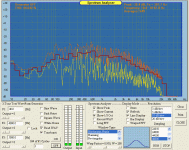For a while now, I've wanted to know how much wattage each driver is actually seeing. Particularly, I have open baffle speakers with lots of EQ boost, and my tweeter is only rated for 10W.
I've thought about building a meter that can measure the actual wattage, and I've seen it done: at the most recent BurningAmp, Mr. Linkwitz had build just such a device. He was using it to measure the instantaneous power applied to the woofers of one speaker. He was playing music loudly, and the average level was around 2.5W. Very loud peaks were around 20W. Not what you'd guess as the amount of juice running through what is considered very inefficient speakers.
(This seems really indicative of the audio world today - assumptions way out of touch with reality, and way to few people creating actual data... )
)
Anyway, I know this could easily be calculated for any given music file - but I can't find any software that will do this. I've been playing with spectrum analyzers, and they show trends, but don't give me the numbers I'm looking for.
My ideal would be a piece of software that can take a file, play it, and will report the power across a specific bandwidth. I suppose you would have to make a few assumptions, like the impedance of the drivers, and what level you are playing it at. It would be easy to preprocess a song to compensate for the EQ and crossover. Perhaps this wouldn't be too hard to figure in MatLab? (Note that I don't have any crossovers after the power amp, so the calculations would be a bit simpler)
I've attached a screenshot of the spectrum of a piece of classical music - and it seems to be indicative of acoustic music. The 1/3 octave bands are a long term average, and the orange line represents the maximum peaks of the song. Disregard the yellow line (it is the instantaneous levels of the music at the moment I stopped it).
Anyone know of any software that will calculate power (rms and peak)?
I've thought about building a meter that can measure the actual wattage, and I've seen it done: at the most recent BurningAmp, Mr. Linkwitz had build just such a device. He was using it to measure the instantaneous power applied to the woofers of one speaker. He was playing music loudly, and the average level was around 2.5W. Very loud peaks were around 20W. Not what you'd guess as the amount of juice running through what is considered very inefficient speakers.
(This seems really indicative of the audio world today - assumptions way out of touch with reality, and way to few people creating actual data...
 )
)Anyway, I know this could easily be calculated for any given music file - but I can't find any software that will do this. I've been playing with spectrum analyzers, and they show trends, but don't give me the numbers I'm looking for.
My ideal would be a piece of software that can take a file, play it, and will report the power across a specific bandwidth. I suppose you would have to make a few assumptions, like the impedance of the drivers, and what level you are playing it at. It would be easy to preprocess a song to compensate for the EQ and crossover. Perhaps this wouldn't be too hard to figure in MatLab? (Note that I don't have any crossovers after the power amp, so the calculations would be a bit simpler)
I've attached a screenshot of the spectrum of a piece of classical music - and it seems to be indicative of acoustic music. The 1/3 octave bands are a long term average, and the orange line represents the maximum peaks of the song. Disregard the yellow line (it is the instantaneous levels of the music at the moment I stopped it).
Anyone know of any software that will calculate power (rms and peak)?
Attachments
For a while now, I've wanted to know how much wattage each driver is actually seeing. Particularly, I have open baffle speakers with lots of EQ boost, and my tweeter is only rated for 10W.
Anyone know of any software that will calculate power (rms and peak)?
If you have an RTA spectrum then you have enough data to know wattage per 1/3rd Octave or wattage over a band.
Usually the 1/3rd octave bands are dB conversions of voltage. Power is v squared over R (DC resistence would be close enough for R).
It is an excel spreadsheet problem but fairly straightforward:
Obtain average or peak output vs. 1/3rd Oct
Unlog the data = 10 raised to the power dB/20
Square and divide by R for power per 1/3rd Octave
Add all the powers of the tweeters range, woofers range etc.
If your RTA doesn't work in calibrated units then you can calibrate by using a true RMS meter and comparing its number with the summed RMS voltage of the RTA.
David S.
That should nail it Dave for the OP's needs.
Here's a link to Rod Elliot's take on the subject (read sub-section 1.3). I struggled a bit with this concept myself and Elliot's writings were the first I found which suggested real numbers.
BiAmp (Bi-Amplification - Not Quite Magic, But Close) - Part 1
Here's a link to Rod Elliot's take on the subject (read sub-section 1.3). I struggled a bit with this concept myself and Elliot's writings were the first I found which suggested real numbers.
BiAmp (Bi-Amplification - Not Quite Magic, But Close) - Part 1
- Status
- This old topic is closed. If you want to reopen this topic, contact a moderator using the "Report Post" button.
